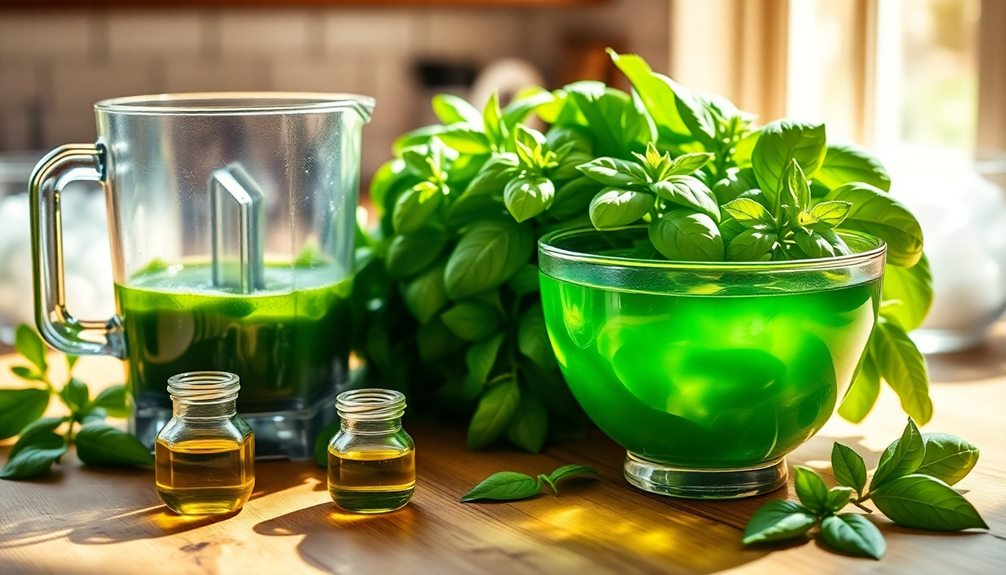You can create vibrant fresh basil oil in just 20 minutes, transforming your dishes with its rich flavor and aroma. Start by blanching fresh basil leaves in boiling water for about ten seconds, then quickly transfer them to an ice bath. Blend the blanched basil with grapeseed and extra-virgin olive oil for depth and smoothness. Strain the mixture through a fine-mesh sieve lined with cheesecloth, and store it in a clean bottle in the fridge. This oil enhances salads, pasta, and grilled vegetables. Stick around for tips on maximizing flavor and customizing your basil oil experience!
Summary
- Blanch fresh basil leaves briefly in boiling water, then transfer to an ice bath to lock in color and flavor.
- Blend blanched basil with grapeseed oil and extra-virgin olive oil for a rich, aromatic essence.
- Strain the mixture using a fine-mesh sieve lined with cheesecloth to achieve a clear, vibrant basil oil.
- Store the strained oil in a clean squeeze bottle in the refrigerator for up to one month to maintain freshness.
- Use basil oil to enhance salads, pasta, and grilled dishes with its vibrant flavor and aroma.
Enhances Dish Aroma and Flavor
Fresh basil oil's vibrant aroma and rich flavor can transform your dishes into culinary masterpieces. Not only does basil oil provide a delightful taste, but it also offers numerous therapeutic properties that can enhance your overall cooking experience.
Imagine drizzling this fragrant oil over a freshly made Caprese salad, enhancing the juicy tomatoes and creamy mozzarella with a burst of herbal goodness. The culinary uses of basil oil extend far beyond salads; it's perfect for marinades, pasta dishes, and even as a finishing touch on grilled vegetables.
When you incorporate fresh basil oil into your cooking, you'll notice how it elevates the overall flavor profile of your meals. Just a few drops can infuse a simple dish with a robust, aromatic essence that'll have your guests asking for your secret. With its invigorating aroma, fresh basil oil can truly elevate your dishes.
Don't forget about its versatility in dips and spreads. Mix it into hummus or pesto for an extra depth of flavor that's sure to impress.
Plus, using fresh basil oil instead of dried herbs can provide a brighter, more nuanced taste, making your dishes stand out.
72,788 Views and Counting
With over 788 views and counting, this basil oil recipe has captured the attention of home cooks and culinary enthusiasts alike. The allure of homemade basil oil lies in its vibrant color and fresh flavor, perfect for elevating various dishes.
As you explore this popular recipe, you'll find that it's not just about creating a delightful oil; it's about sharing a culinary experience that resonates with many. Additionally, infused oils like basil oil can enhance your cooking with natural flavors and aromas, similar to how cassia essential oil can uplift your mood and health.
The surge in views reflects a growing interest in simple, flavorful cooking techniques. People enjoy the idea of transforming fresh basil into a versatile oil that can be drizzled over pasta, used in dressings, or as a dipping oil. Each view signifies a cook enthusiastic to embrace the freshness of homemade basil oil in their kitchen.
Curiosity drives this engagement, as many users share their experiences and modifications in the comments section. You'll see questions about ingredient substitutions and tips for perfecting the oil's flavor.
This interaction fosters a community of food lovers, all seeking to master this aromatic basil oil recipe. So, why not join the fun and create your own batch? You might just find yourself captivated by the vibrant essence of basil!
Basil Oil Preparation Method
To create a vibrant and flavorful Fresh Basil Oil, start by gathering fresh basil leaves, as they're the key ingredient in this recipe. The process begins with blanching the basil to preserve its vibrant green color and fresh flavor. In addition to enhancing the basil's natural taste, you might find that incorporating vital oils like clary sage can provide calming benefits that elevate your culinary experience.
Blanching briefly in boiling water followed by an ice bath helps lock in the basil's natural oils while preventing any loss of color or taste. After the basil has been properly blanched and dried, it's blended with oils to create a smooth mixture that will serve as your basil oil base.
The next step involves combining the blanched basil with grapeseed and extra-virgin olive oils. This blend not only enhances the flavor but also provides a beautiful green hue to the final product. Once blended, refrigerating the mixture allows the flavors to meld, resulting in an aromatic oil that can elevate various dishes.
The final step is straining the mixture to achieve a smooth oil that's ready for use.
Ingredients:
- 1 large bunch of fresh basil
- 1/2 cup grapeseed oil
- 1/2 cup extra-virgin olive oil
To prepare the basil oil, begin by washing the basil and separating the leaves from the stems. Boil a large pot of water and blanch the basil leaves for about 10 seconds before transferring them to an ice bath to halt the cooking process.
After cooling, squeeze out any excess moisture and dry the leaves thoroughly with paper towels. Place the dried basil in a blender, add the grapeseed oil, and blend until smooth. Then, incorporate the extra-virgin olive oil and blend again until the mixture is uniform.
Transfer the basil oil mixture to a container and refrigerate it for at least 8 hours or overnight. Once the flavors have melded, allow the mixture to come to room temperature and strain it through a sieve lined with cheesecloth to extract as much oil as possible.
Store the strained oil in a small squeeze bottle and refrigerate it for up to one month.
When making basil oil, it's critical to verify that the basil is completely dry before blending to prevent excess moisture from affecting the oil's consistency and shelf life. Additionally, using a combination of oils not only balances the flavor but also enhances the oil's stability.
Experimenting with different types of oils or adding other herbs can create unique variations of basil oil, allowing for personalized culinary creations. Always remember to keep the basil oil refrigerated to maintain its freshness and flavor.
Basil Preparation Techniques
Basil preparation techniques are vital for maximizing the herb's flavor and aroma in your dishes. To start, you'll want to wash the basil leaves thoroughly to remove any dirt or impurities.
Once clean, separate the leaves from the stems, as the stems can be bitter and detract from the overall flavor. One of the best methods to enhance the color and taste is blanching basil. This quick process involves briefly boiling the leaves, which helps to set their vibrant green color and preserve their fresh taste.
After blanching, immediately plunge the basil into an ice bath. This stops the cooking process and locks in that bright flavor.
Once cooled, squeeze out any excess moisture and pat the leaves dry with paper towels. This step is essential because excess water can dilute the flavorful basil oil you're about to create.
Step 1. Blanch Basil in Boiling Water
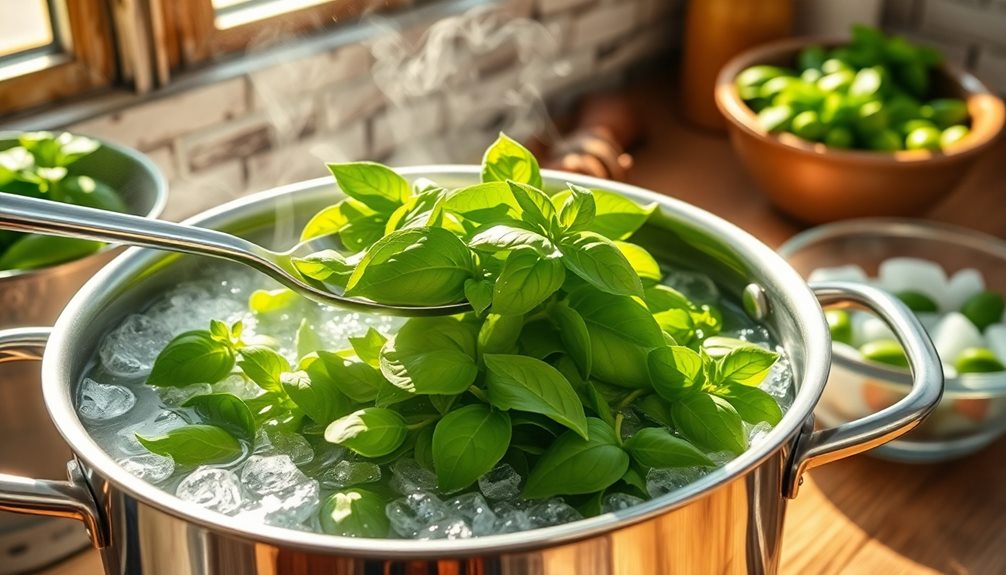
When you're ready to enhance the vibrant flavor of fresh basil, blanching it in boiling water is a key technique. This process not only sets the color but also helps to preserve the fresh taste of basil, making it an important step in how to make basil oil.
Additionally, using essential oils such as black pepper oil can further enhance your culinary experience by adding a warm and spicy aroma. Start by washing your basil thoroughly and separating the leaves from the stems.
Bring a large pot of water to a rolling boil. Once boiling, carefully add the basil leaves and blanch them for about 10 seconds.
After that brief moment, quickly transfer the blanched basil to an ice bath. This sudden cooling stops the cooking process, locking in that bright green color and fresh flavor.
Once the basil's cooled, squeeze out any excess moisture and press the leaves between paper towels to dry them thoroughly. This step is vital for the final texture and flavor of your basil oil ingredients, ensuring the oil won't become watery.
Step 2. Blend Basil With Oils
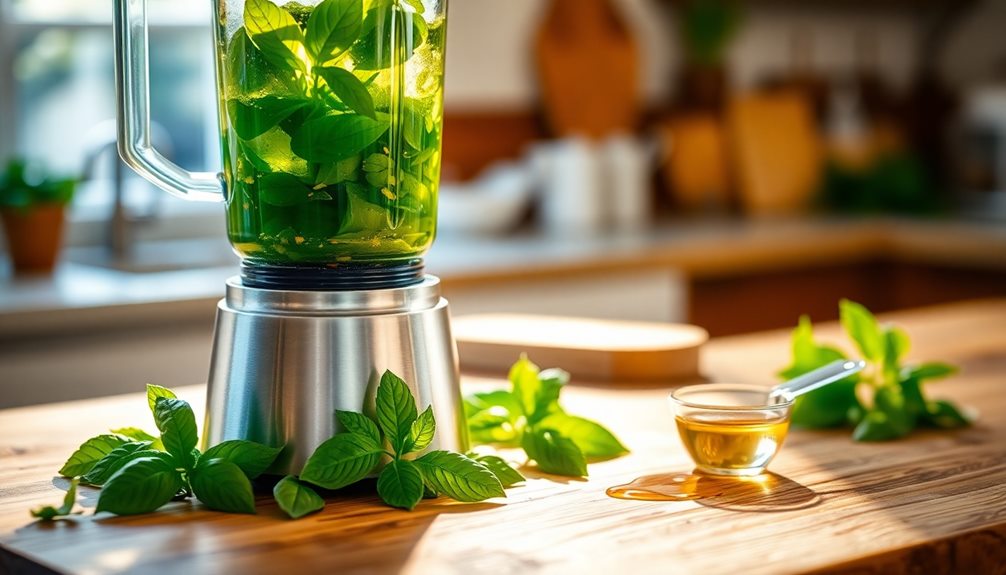
Blending the blanched basil with oils creates a luscious, vibrant mixture that captures the essence of fresh basil. The addition of essential oils can enhance the aromatic profile, providing a delightful experience that rejuvenates the senses, similar to the benefits of aromatherapy and healing insights.
Start by placing the cooled, blanched basil leaves into your blender. This is where the magic happens! Pour in half a cup of grapeseed oil, which will help to maintain that bright green color while providing a neutral flavor. Blend this until it's smooth and creamy.
Next, add half a cup of extra-virgin olive oil for richness and depth. Blend again until everything is fully incorporated. The result is a fragrant, velvety mixture that's perfect for creating your own DIY basil oil.
This basil oil isn't just a treat for the senses; it serves as a fantastic basil oil for cooking. Drizzle it over pasta, use it in salad dressings, or enhance your marinades with this aromatic infusion.
Once blended, transfer your vibrant basil oil to a container and let it sit in the refrigerator for at least eight hours or overnight. This waiting period allows the flavors to meld beautifully, ensuring that every drop bursts with the freshness of basil.
Enjoy your homemade basil oil!
Step 3. Strain Through Cheesecloth
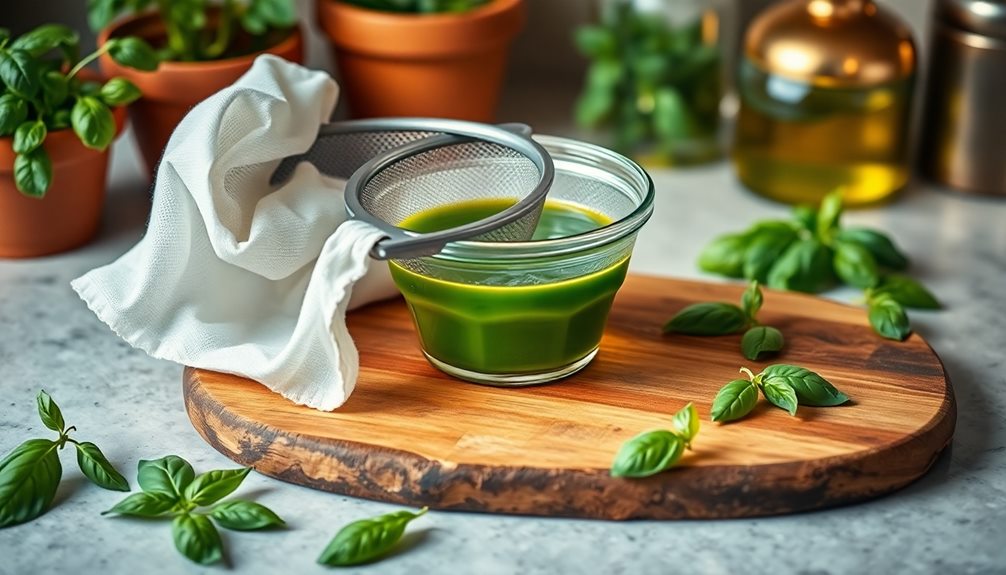
After letting your basil oil sit for the recommended time, it's essential to strain it to achieve a smooth, refined texture. This step not only enhances the clarity of the oil but also helps to preserve its vibrant flavor.
Begin by bringing the basil oil to room temperature. This step is important because it guarantees the oil flows smoothly during the straining process. Chamomile essential oil is another example of an infusion that can bring soothing benefits to your wellness routine.
Next, set up a fine-mesh sieve lined with cheesecloth over a bowl or measuring cup. Pour the basil oil mixture through the sieve. As the oil drains, gently press down on the cheesecloth to extract as much oil as possible. This straining basil oil technique not only removes any solid bits of basil but also enhances the final product's clarity and flavor.
Once you've strained out the solids, transfer the vibrant basil oil into a small squeeze bottle for easy basil oil storage. Confirm the bottle is clean and dry to maintain freshness.
You can refrigerate the oil for up to one month, allowing its flavors to deepen even further. By following these straining steps, you'll have a beautifully refined basil oil ready to elevate your culinary creations!
Step 4. Refrigerate for Flavor Infusion
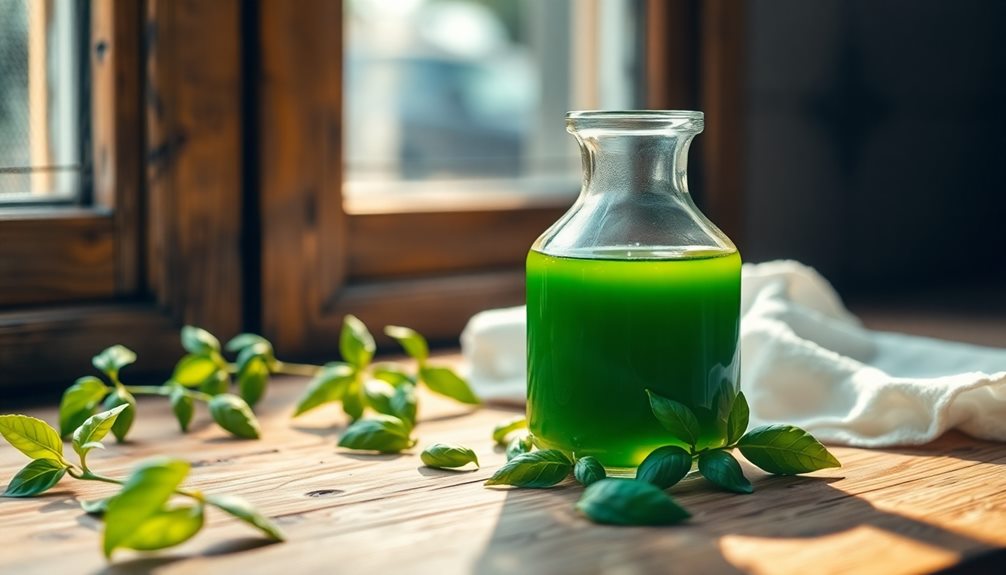
Chilling the basil oil allows the flavors to meld beautifully, enhancing its vibrant taste and aroma. By refrigerating basil oil, you're not just preserving it; you're also elevating the overall flavor profile. The chilling process helps the fresh herb oils to infuse thoroughly, creating a more robust and aromatic oil that can transform your dishes.
Additionally, incorporating essential oils like bay can offer potential therapeutic benefits that complement your culinary creations, enhancing both flavor and wellness.
Here are some benefits of refrigerating your basil oil:
- Flavor Enhancement: Intense and well-rounded taste.
- Aroma Boost: Fresh and inviting scent.
- Longer Shelf Life: Keeps the oil fresh for up to 1 month.
- Versatile Use: Perfect for drizzling over salads, pasta, or grilled meats.
- Easy Storage: Conveniently stored in the fridge.
After blending and straining, simply transfer your basil oil to an airtight container and pop it in the refrigerator. Aim to let it chill for at least 8 hours, or overnight for ideal flavor infusion.
You'll notice how the chilling process allows the fresh herb oils to mingle, giving you a truly delightful basil oil that will elevate any meal. Enjoy the culinary magic that your homemade basil oil brings!
Step 5. Taste Test for Freshness

Once your basil oil has been refrigerated for ideal flavor infusion, it's time to check its freshness. Start by pouring a small amount into a clean tasting spoon. Take a moment to admire the vibrant green color, a telltale sign of your hard work.
Now, bring the spoon to your lips and take a gentle sip. You should experience a rich, aromatic burst of basil that's both fresh and slightly peppery. This is the hallmark of a successful popular basil oil recipe. The freshness of the basil is essential, as it can greatly impact your dish's flavor, much like how the calming properties of Balsam oil enhance relaxation.
Next, consider the oil's texture. It should feel silky on your palate, with a smooth finish. If it tastes flat or stale, it might be a sign that the basil or oils weren't fresh to begin with.
Remember, grapeseed oil uses can enhance your basil oil's flavor profile, but if the base oil lacks freshness, it'll affect the overall taste.
Lastly, trust your senses. If the aroma is overpowering or off-putting, it may not be suitable for use.
Enjoy this vibrant basil oil in salads, pastas, or as a dipping oil, and savor the freshness that comes from your kitchen!
Final Thoughts
There's something truly rewarding about crafting your own fresh basil oil. Not only does it elevate your culinary creations, but it also harnesses the numerous extra-virgin olive oil benefits, such as its rich flavor and health properties.
Additionally, incorporating essential oils like bergamot can further enhance your cooking experience by providing uplifting and calming aromas, which can be beneficial in reducing stress and improving mood known for its uplifting properties.
As you explore this delightful recipe, you'll discover the joy of homemade oils that enhance the taste of your dishes.
- Fresh basil oil adds a vibrant touch to salads and marinades.
- It's quick and easy, taking just 20 minutes of your time.
- User reviews basil oil highlight its versatility in cooking and drizzle applications.
- You can customize the flavor by experimenting with different oils.
- The vibrant green color adds an aesthetic appeal to your dishes.
FAQ
Can I Use Dried Basil Instead of Fresh Basil?
You can use dried basil, but it won't provide the same fresh flavor and vibrant color. Fresh basil infuses a brighter taste, while dried offers a more concentrated essence. Adjust your quantities accordingly for the best results.
What Dishes Pair Well With Basil Oil?
You'll love drizzling basil oil over pasta, pizzas, or salads. It enhances flavors in marinades and dips, while also elevating grilled vegetables or meats. Experiment to find your perfect pairing for a vibrant touch!
How Do I Know if the Oil Has Gone Bad?
To know if your oil's gone bad, smell it first; rancid oil has an off, sour odor. Also, check for cloudiness or sediment. If you notice either, it's best to discard it.
Can I Mix Basil Oil With Other Herbs?
Absolutely, you can mix basil oil with other herbs! Combining oils like oregano or thyme enhances flavors and adds complexity. Just guarantee the herbs complement each other for a harmonious blend that elevates your dishes.
Is Basil Oil Safe for Cooking at High Temperatures?
Basil oil isn't ideal for high-temperature cooking. It can lose its flavor and beneficial properties. Instead, use it for drizzling or finishing dishes, enhancing your meals without compromising its vibrant taste and aroma.
